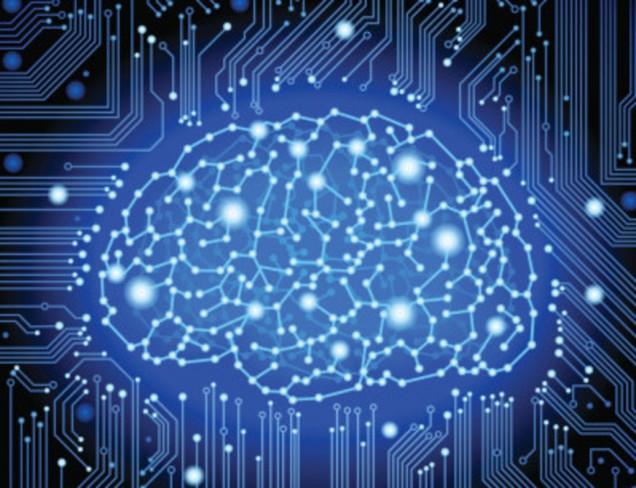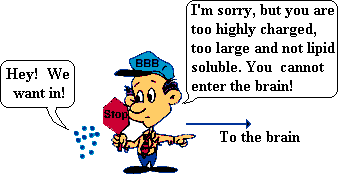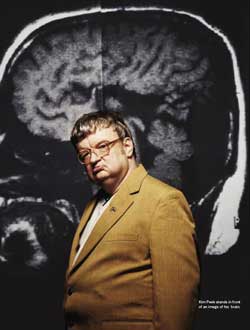Would You Go Skydiving?

If you like to skydive or participate in other dangerous, adrenaline-inducing activities such as extreme sports or doing drugs, you may be someone who is easily bored or impulsive. People who demonstrate “novelty seeking” behavior tend to prefer new or unexpected experiences. Studies show that these new experiences release pleasure chemicals, or dopamine, in the brain, which may be why some people are drawn to dangerous activities.
Dopamine is a neurotransmitter that regulates the brain’s reward and pleasure centers. Rewarding experiences, such as eating, activate the dopamine system, which then controls how we perceive the task we’re doing and the reward or failure associated with it. Dopamine is used to treat movement symptoms in Parkinson’s disease. A study found that 17 percent of Parkinson’s disease patients who took drugs that stimulate dopamine receptors developed unpredicted behavioral addictions. They were also more likely to engage in risky behaviors and demonstrated a preference for novelty. This study shows that an active dopamine system is positively correlated to the likelihood of taking risks.
Another study found that anticipating a win can increase brain activity in dopamine regions, whereas anticipating a loss decreases such activity. As expected, our expectation of a win or reward encourages us to take a risk. But similarly, the urge to avoid a loss also drives us to take a risk. Therefore, someone who is drawn to the thrill of skydiving may be acting on their urge to avoid serious loss, such as death.
It turns out that our chances of taking a risk can be manipulated. Research on rats shows that risk taking can be reduced by mimicking the dopamine signal that provides information about previous negative outcomes. The risk taking behavior of binge drinkers can also be reduced by experiencing, rather than expecting, a loss outcome.
So what makes some people more likely to be thrill-seeking than others? The answer has to do with both nature and nurture. Studies have found that people who have a specific dopamine receptor are more likely to engage in risky behavior. This gene variant may cause an increase in the release of dopamine in the brain when presented with unexpected rewards, making the new experience more thrilling. On the other hand, people may also be more likely to engage in thrill-seeking behavior due to the peer pressure to conform, or when the individual is feeling especially sad or stressed.
~Sophia Hon
Sources:
http://www.medicaldaily.com/risky-business-dopamine-influences-brain-take-risky-decisions-302500
https://theconversation.com/why-danger-is-exciting-but-only-to-some-people-64680
Image source:
Blinded By Our Beliefs?

Nearing the end of this election season, we can see the great divide between Trump supporters and Hillary supporters. Both sides of the election show a great deal of unwavering support for their candidates. We can see that these supporters remain uncritical and unfazed when either candidate is involved with a scandal. What if there was science to explain why Hillary and Trump supporters are so unwilling to rationally criticize their candidate of choice?
In John Hartung’s article for the Foreign Policy Journal, he introduced research from Danish scientists that explains what happens to our brains when we hear people “preach” our beliefs. The study had two groups split up into how they identified: religious or non-religious. These people were put into MRI scanners and listened to recording of a pastor preaching. Those who identified as more religious had something happen to their brains compared to those who identified as non-religious – their medial and dorsolateral prefrontal cortices shut off. The prefrontal cortex is the part of the brain that coordinates our executive functions like: decision making, planning complex cognitive behavior, personality expression, and moderating social behavior. Now, this kind of reaction in our brains isn’t just limited to religious sermons, but is also likely relevant to our political beliefs.
Now we know why our Facebook newsfeed is filled with people from both political parties constantly defending their candidate: hearing political candidates "preach" their beliefs may be affecting their brains, preventing them from fully recognizing that their belief system and candidate could be flawed. This could also be why a lot of Trump supporters are completely unfazed by his various sexual assault scandals, and are willing to believe anything Trump says without question. The same goes for Hillary's supporters who are willing to defend her despite her various scandals. This research gives us great insight on one possible reason behind people's unwavering support for their favored candidate. With this in mind, we should all use our best judgment to vote on November 8th, and consider every aspect when choosing who we believe is the right candidate.
~Cindy Wu
Sources:
http://www.goodtherapy.org/blog/psychpedia/prefrontal-cortex
Image source:
http://midnightsunak.com/wp-content/uploads/2016/10/clinton-vs-trump-1.jpg
Is this Real Life or Virtual Reality?
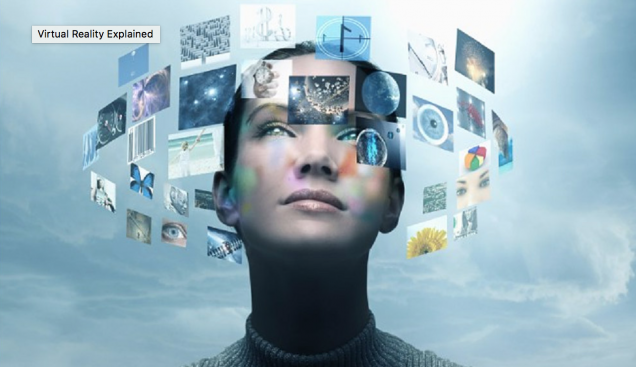
In recent years, many new technologies have been aiming to make virtual reality a thing of the present rather than just a vision. Defining virtual reality as experiencing an illusion different from that of the present, achieving virtual reality immersion has always been a goal of ours starting from the 1800s. No actual machine was created however, to experience the all senses until the 1930s-1950s with the creation of the Sensorama by Morton Heilig, and even then the machine was too big to carry around. Currently, we have many devices that actually simulate ourselves in a virtual environment and are a lot more mobile than they were in the past. Oculus Rift, HTC Vive, and even Google Cardboard are all different ways you can experience a dimension different from the present. Although we may view these worlds as different, new studies have begun connecting virtual reality to real life applications.
A recent study has shown that virtual reality is now being used to show how our brain may use perception and not sensation to regulate emotions and behavior. This study, done by Dr. Dobricki and Dr. Pauli, was done by having healthy people explore a VR-simulation of a forest glade. They had the participants walk across a plank with each of the participants given oneof four different set ups: having the height be either that of the trees or that of the ground and/or having the plank be bouncy or steady. The results showed that having a bouncy plank compared to that of the steady plank on a high pillar made the head look mainly below the horizon and had the participant mark the experience as negative. However, while the bouncy plank instead of the steady plank was on the ground surface, the participants had the head above the horizon and rated the experience as positive. These results largely show how perception and not necessarily the sensation of an environment could shape individuals’ emotions and behavioral responses. With that being said, many techniques of therapy have already begun adopting VR-stimulation in therapeutic practices because of its ability to affect people’s emotions.
New therapeutic techniques have been adopted with the rise of VR. The new adoration for the new technology comes from virtual reality’s ability to have control over variables while creating a naturally rich experience. Difficulties in traditional therapeutic techniques include the difficulty of creating a controlled environment, without sacrificing the ecological validity of said environment. VR has maximum control over the environment while allowing for a natural environment for the patient to behave in. With this practice being more and more accepted, maybe VR will start to be a part of everyday life and soon integrate with what we know to be reality. Time can only tell what new technologies this world will bring.
~ Albert Wang
Sources:
Virtual Reality Study Finds Perceptions of Body and Environment Affect How We Feel
Virtual reality in neuroscience research and therapy
Sensorimotorbody-environment interaction
Image Source:
Morally Speaking…

In some situations, we end up surprising ourselves by how we act. These are the moments when we act automatically without thinking. It is as if we really didn’t know what was going to happen.
We have different narratives running through our minds, even without our conscious awareness. Underlying these narratives are complex networks of axonal tracts, synapses, and feedback loops. They interconnect and correspond in ways we don’t yet know, revealing explanations for human behavior that cannot otherwise be explained. One such explanation proposes that moral judgment and moral action are two separate entities, processed differently within and across individuals.
A study conducted at Plymouth University reveals compelling evidence for separate processes defining moral judgement and action. By comparing predicted action in textbook moral paradigms and actions in virtual reality moral paradigms, the research team revealed divergent results that suggest separate mechanisms.
In the textbook paradigms, most predicted that they would not sacrifice others for a greater good, whereas in the virtual reality paradigm, they did act in a utilitarian manner. Interestingly, antisocial traits in subjects were also examined, and such traits only predicted actions in the virtual reality paradigm. These findings show that there can be stark differences between what we say we would do and what we would actually do. It also shows that to get better insight regarding what people might actually do, virtual reality is a useful tool and testing paradigm compared to other non-realistic methods.
Clearly, morality is a complex human trait. A study like this shows us why we may have such difficulty making hard moral decisions. Trying to reconcile what we think we would do versus what we would actually do might be so hard simply because our brains make it that way.
~ Jackie Rocheleau
Sources:
People Switch Morality in the Heat of the Moment
Virtual Morality: Transitioning from Moral Judgment to Moral Action?
Image source:
http://medina-psicologia.ugr.es/~cienciacognitiva/files/2015-17-f1.jpg
The Mystery of Oxytocin

What exactly is oxytocin? You may have heard it referred to before as the “love hormone,” since it is commonly associated with good feelings and emotions, but in truth, oxytocin serves as both a complex hormone and neurotransmitter, producing a variety of responses particularly in the brain.
The oxytocin that affects behavior is produced in the brain and spinal cord, specifically their centrally projecting oxytocin neurons, as oxytocin secreted from the pituitary gland cannot re-enter the brain due to the blood-brain barrier. The neurons expressing oxytocin receptors can be found in various regions of the brain such as the amygdala, brainstem, and ventromedial hypothalamus.
Since the 1970s, various studies have recorded how oxytocin affects social interaction in different species. Oxytocin has been shown to influence monogamous pair bond formation in voles, mother-infant bonding in sheep, and trust in humans. Thus, the molecule has earned a reputation as a “cuddle” hormone capable of improving social interaction, which has resulted in some clinicians to try to use it in order to treat certain psychiatric conditions such as autism spectrum disorder. However, since the early trials have had mixed results, scientists are currently striving to obtain a better understanding of how oxytocin works in the brain.
More recent studies have shown that oxytocin suppresses inhibitory neurons (which reduce neural activity), thereby allowing excitatory cells to respond more strongly and reliably. As a result of improved signal transmission, oxytocin appears to overall enhance the brain’s response to socially relevant stimuli. In addition, oxytocin has been shown to work along with the serotonin neurotransmitter to increase inhibition in the nucleus accumbens, a brain region involved in the reward circuit.
Although scientists have begun to realize the importance of oxytocin in analyzing social information, more research must be done in regards to how the molecule helps the brain to process social stimuli and how it affects various neural circuits before it can effectively be used along with behavioral therapies to treat psychiatric conditions.
~ Nathaniel Meshberg
Sources:
Fact or Fiction?: Oxytocin is the "Love Hormone"
Neuroscience: The hard science of oxytocin
Image source:
http://www.bodecology.com/images/Body411/under-the-molecule-oxytocin-banner.jpg
Emotion Learning Computers: The Path to Artificial Intelligence
Reading and responding to emotions often tends to be a very humanistic thing to do. To be able to understand how one is thinking and how one will respond appropriately, typically is what many would regard as making people human. Recently however, researchers have found that computers may be able to read a person’s body language to see whether they are bored or interested in what is happening on the screen. Dr. Harry Wichel, Discipline Leader in Physiology at Brighton and Sussex Medical School, has shown in his new study that by measuring a person’s movement through a computer, a person's interest can be judged by following tiny movements; while someone is fully engaged in what they are doing - small involuntary movements decrease, and vice versa. It is said that with this technology, future applications such as online tutoring could be better used as they can be adjusted based on the person’s interest.
This progression in technology is a giant leap for the prospect of artificial intelligence. Having computers respond to emotions and interests of an individual and act accordingly makes it so that humans do not have to control the computer, but rather the computer has control over itself. Examples of artificial intelligence, or at least the very beginnings of it, have already been made - such as with automatic car controls, or flying drones. This is a new leap for artificial intelligence and the question now becomes whether we are able to continue on this path without any consequences. What will artificial intelligence be like in a few decades? How will we prepare for that day? Only time will be able to tell, but we are progressing fast.
~Albert Wang
Sources:
Examples of Artificial Intelligence
Computers Can Tell If You’re Bored
Image Source:
New Advances in Drug Therapy: Crossing the Blood Brain Barrier
Recent research has discovered new ways to deliver drugs to the brain through the blood brain barrier. This blood brain barrier is created by specialized cells that safeguard the brain from unwanted substances. Cornell researchers were able to create a drug called Lexiscan, which activates receptors that are on the blood brain barrier. Their goal in developing this drug was to open the barrier for a brief amount of time, just enough to deliver the pharmacological treatment to the brain in order to treat neurological disorders. They were able to make headway by delivering chemotherapy drugs into the brains of mice with Lexiscan and then having the antibodies bind onto the Amyloid-β plaques present in Alzheimer’s disease. This new breakthrough shows not only a new development in the pharmaceutical industry, but a new approach to treat diseases that would otherwise be left untreated because of the inability of other therapies to pass through the blood brain barrier. Diseases such as Alzheimer’s, Parkinson’s, autism, and brain tumors that were otherwise unable to be treated with drug therapy, all have a new potential to be cured as drugs are now able to cross the blood brain barrier.
~Albert Wang
Sources:
Opening the Blood-Brain Barrier to Deliver Drugs For Brain Diseases
A2A Adenosine Receptor Modulates Drug Efflux Transporter P-Glycoprotein at the Blood-Brain Barrier
Image Source:
Should Pregnant Women Exercise?
Good news! If you have no motivation to exercise, it may not be your fault. Blame your mom instead! Studies at Baylor College of Medicine with pregnant mice show that mice that exercise more (on a volunteer basis) are more likely to produce offspring that are also physically active in adulthood. This study correlates with observational studies in humans that have shown that more physically active pregnant women produce physically active children. In addition, physical exercise when pregnant could also lead to higher neural functioning in the offspring.
The experimenters at Baylor Medical postulate that exercise chemically influences fetal brain development, providing the offspring with a neurological impetus for exercise. This study examines what is referred to as “developmental programming,” or how actions during pregnancy can influence fetal development. During fetal development, the brain undergoes A LOT of development with complex cell division and migration choreography occurring throughout the duration of pregnancy. This means that there is ample time for the mother to influence, positively or negatively, the neural development of her child, as seen in babies born addicted to certain drugs. Although physical activity of the mother does not influence the fetus in the same way that drugs do, it does appear to be quite impactful, visibly influencing the baby after birth and throughout life.
Doctors have recommended exercise for pregnant women for years, and these findings provide another motivation for the prescription. The study also notes that aside from inducing a propensity for physical activity, exercising during a pregnancy can also increase the child’s short-term memory and spatial learning capacities. Not only can exercise influence exercise affinity, but it can also affect how a child learns.
~Jackie Rocheleau
Sources:
Baby, Are We Born To Run? Love of Exercise Begins in the Womb
Maternal Exercise During Pregnancy Promotes Physical Activity in Adult Offspring
Image Source:
Savant Syndrome
The award-winning movie “Rain Man” tells a story about a car dealer and his autistic brother, Raymond, who go on a life-changing, cross-country trip. The character Raymond from this popular movie was inspired by Kim Peek, a savant in real life. Savant Syndrome is a condition in which someone with a mental disability demonstrates profound and exceptional abilities beyond what is considered normal, and it is incredibly rare. In fact, there are currently fewer than 50 savants existing in the world. Although savant syndrome is commonly associated with autism, such as in “Rain Man,” many savants are not autistic and most people with autism are not savants.
Kim Peek, or “Rain man,” suffered from FG syndrome, a genetic condition that affects intelligence and behavior. He also lacked a corpus callosum, which is the bundle of nerve fibers connecting the two hemispheres of the brain, and was born with macrocephaly—a condition in which the brain is enlarged. Due to these brain abnormalities, Kim developed many special abilities, such as an astounding memory and advanced mental calculation and speed-reading skills. Kim was able to read both pages of a book simultaneously while retaining 98 percent of the information. On the other hand, Kim also had difficulties with many tasks, such as logistical math problems, following certain directions, and reduced physical coordination.
If you are interested in finding out more on this topic, this documentary gives a more in-depth look into Kim Peek’s life.
~Sophia Hon
Sources:
Kim Peek, Inspiration for ‘Rain Man,’ Dies at 58
Professor Somers's Lectures
Image Source:
What We Think We See – Why the Real World is Confusing
Most of us rely on our eyes in order to help us interact with the world on a daily basis. Yet the visual system often distorts what we see, so what we think we see is actually an altered reality. According to Dr. Mareschal, as quoted in an article published in Proceedings of the National Academy of Science, “[i]n fact a lot of it is distortion, and it is occurring in the early processing of the brain, before consciousness takes over. Our [researchers from the University of Sydney’s School of Psychology and The Vision Centre] work shows that the cells of the primary visual cortex create small distortions, which then pass on to the higher level of the brain, to interpret as best it can…And we found that even the higher brain cannot always correct for them, as it doesn’t in fact know they are illusions.”
In agreement with previously discovered results, Dr. Mareschal and her colleague Professor Clifford found that these illusions were occurring during early processing in the brain, prior to consciousness. They then went on to be the first labs to report being able to connect the origin of the tilt illusion to the cells of the primary visual cortex, a highly specialized region in the occipital lobe of the brain. Let me take this chance to explain what the tilt illusion is. Take a look at this image before reading on:
What direction do the lines of the inner circle appear to be rotated in: clockwise, counterclockwise, or not at all? Notice how the lines in the inner circle appear to be tilted counterclockwise. Here’s the catch though: they’re actually vertical.
Why is this? According to Mareschal and Clifford, the brain looks to the surroundings for contextual information in order to determine the pattern and alignment of an image. Therefore, because the lines in the outer circle are tilted clockwise and because the lines in the inner circle are tilted away from those of the outer circle, the brain concludes that they must be sloped counterclockwise, while the truth is they are simply vertical.
Here is an example of how our brain utilizes context clues to help us form images in our brain: What are these broken pieces a part of?
 Via Ink Covered Optical Illusions
Via Ink Covered Optical Illusions
Can you see it now?
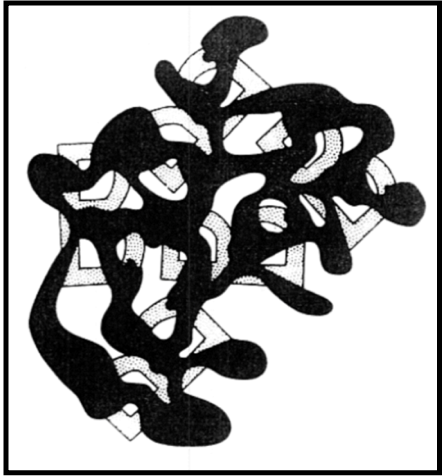 Via Ink Covered Optical Illusions
Via Ink Covered Optical Illusions
The only thing that changed between the first picture and the second picture is the presence of the spilled ink. In the first image, there is too much empty space for the brain to piece together the image because the missing pieces of the image and the background are both white. However, in the second image, the black ink connects the pieces of the image, allowing our brain to put them together into a familiar object - the letter B. Here, we use the presence of contextual clues to trick our brains into recognizing the image.
Here is a final example of how our brain can be tricked by contextual information: Is square A or square B darker?
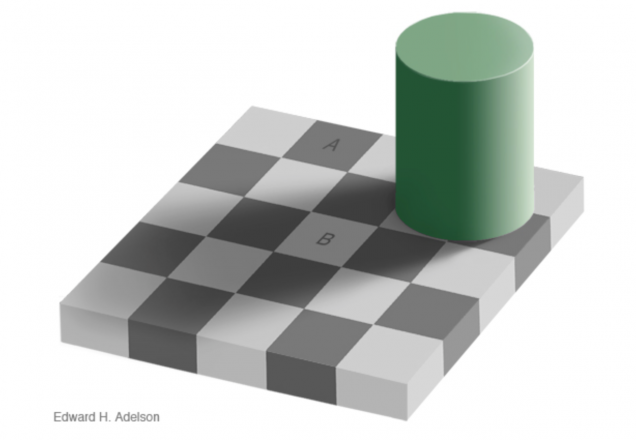 Via mit.edu
Via mit.edu
Trick question! The two squares are actually the same shade of grey, despite the fact that they appear different. We are able to see this by connecting the two squares with grey strips of the same shade throughout.
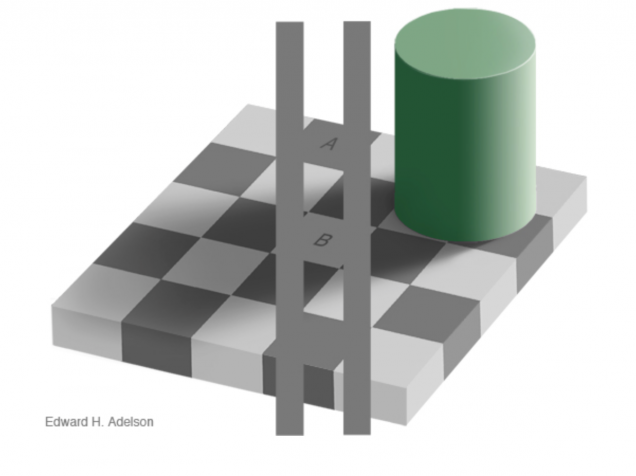 Via mit.edu
Via mit.edu
In order to explain this, we need to discuss the successes demonstrated by our visual system as well as the failures while interpreting this image. Notice that square A is supposedly a dark checker and square B is a light one. Due to the arrangement of squares on a checkerboard, lighter checkers will be surrounded by darker checkers and, likewise, darker checkers will be surrounded by lighter ones. Despite the presence of the shadow, ultimately making all of the checkers within the shadow a “darker shade of paint,” square B is still surrounded by darker tiles. This contextual information cues our brain to recognizes B as a light checker and A as a dark one, although we have now proven that they are actually the same shade of grey.
So to summarize: “All I know is that I know nothing” ~ Socrates
~Alexa Aaronson
Sources:
Professor Gavornik’s Principles of Neuroscience Lectures - Thanks!
Image Source:
